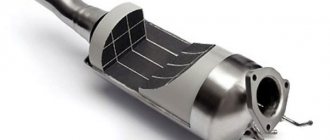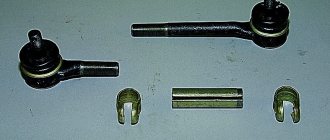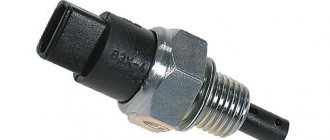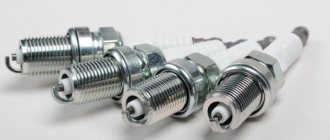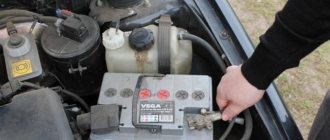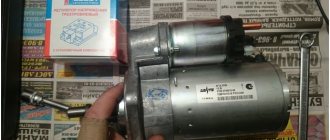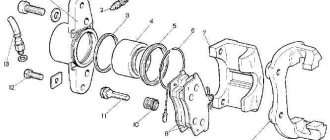Malfunctions and their symptoms
Catalyst problems usually appear with age: by 150–200 thousand kilometers, the honeycombs that make up its filling are almost completely destroyed and prevent the exhaust gases from escaping. As a result, the pressure in the exhaust system increases, the exhaust gases are squeezed back into the engine, which literally “chokes” it. Signs of a clogged catalyst may include:
- severe deterioration in vehicle dynamics;
- uneven engine operation at idle speed;
- starting deterioration;
- smell of sulfur in the cabin.
If the car “does not drive”, before changing the sensors, it is worth checking the condition of the cata at a service station. in a garage environment : not everyone in the household has the necessary devices. There are two main methods of checking: manometric and pyrometric.
Replacing the catalyst on an 8-valve VAZ 2114
REMOVAL THE CATALYST AND SIGNS OF A CLOGGED CATALYST IN VAZ, LADA
REMOVING THE CATALYST
AND SIGNS OF A CLOGGED
CATALYST IN VAZ
2110, 2111, 2112,
2114
, 2115, LADA PRIORA, .
Removing the catalyst VAZ 2114,15,13
What problems happen with the VAZ catalyst
and ways to solve them!
On cars with an 8-valve engine, the catalyst is located under the bottom after the exhaust manifold and in front of the middle resonator. It is not customary in Russia to replace the catalyst with a new one and take care of the atmosphere: it is expensive and “strangles the engine.”
But you can’t just take and remove the catalyst and weld a pipe in its place (put in a corrugation). The noise of the car will become unbearable, and the hot exhaust gases will quickly burn out the muffler. The most budget-friendly method: cut the catalyst, knock out the ceramic honeycombs with a pry bar and weld the body back together. But this method is also the noisiest.
Replacing the catalyst on a 16-valve VAZ 2114
On a VAZ 2114 with a 16-valve engine, the catalyst is structurally combined with the output manifold and is located in the engine compartment immediately behind the cylinder block. To replace it, a special insert is used, catalyst , better known as a “spider”. Removing the catalyst and installing a spacer can also be done in a garage . To gain access, you will need to remove the fuel rail.
The peculiarity of removing the catalyst on 16-valve VAZ 2114 cars is that there are two lambdas. The first is installed on the catalyst itself and is responsible for setting the fuel mixture, and the second, “ecological”, is located on the flange after the catalyst. Its absence will inevitably cause a sensor error, a check engine indication, incorrect injection operation, increased fuel consumption and poor traction. There are two ways out of this situation.
- If you purchased a spider for one sensor, the ECU needs to be flashed from Euro-3 to Euro-2. In addition, the spider for one sensor has a drawback: the only thread for the lambda probe is located on the flange. To screw in the “injection” lambda, you need to assemble an extension cord from two male-female connectors and a wire.
- If there is a spider for two sensors, the “injection” lambda can be installed in its original place. The thread for the second sensor can be plugged or a “dummy” for the computer can be installed there. In the second case, flashing the ECU to Euro 2 will not be required.
Is it necessary to flash the car after removing the cathode collector?
As soon as the catalyst is cut out, the second oxygen sensor, which is used to diagnose it, will quickly “detect the loss.” The corresponding signal will go to the engine ECU. The controller will begin to inject gasoline in emergency mode, and the Check Engine icon will light up on the panel.
To prevent this from happening, the control unit needs to be reflashed! The task of the new controller firmware is to disable the recording of data from the oxygen sensor installed after the converter.
Breakdowns and their signs
Typically, this element begins to “strange” when it travels about 150 thousand kilometers. That is, this is more likely an age-related problem with the car.
Standard and Modified
Typical signs that the catalyst is clogged are:
- The car's dynamics deteriorate significantly and noticeably;
- The engine starts with problems;
- There is a characteristic smell of sulfur in the cabin;
- The engine is unstable at idle.
If the car stops driving normally, it is advisable to immediately check the condition of this device. Alas, this cannot always be done in a garage environment, since special equipment and devices are required. But there are still two ways.
- Replace the lambda probe with a pressure gauge. Start the engine and check the pressure. If it is more than 0.5 atmospheres, things are bad.
- In the second case, you will need a remote pyrometer. If the catalyst is working normally, the temperature of the pipe before it will be higher than after it. But at the same temperature, this indicates the destruction of the honeycomb and a violation of the flame extinguishing function.
The second method allows you to obtain indirect data, so the pressure must be checked in any case. If a breakdown is detected, the catalyst must be replaced.
Design Features
How does the catalyst work? "Priora" in terms of its design is no different from other modern cars. The part consists of a steel body (can) and a working element - metal honeycombs, the surface of which is coated with an active substance that promotes heating of the exhaust. The latter is a platinum-iridium alloy.
Unburned harmful impurities, passing through the honeycomb of the device, settle on the surface of the catalytic layer and, under the influence of high temperature, continue to burn, oxidizing almost completely. As a result, at the output we have an exhaust with a minimum amount of harmful substances.
Replacement for an 8-valve engine
Device option for eight-valve
Some believe that instead of a failed filter device, you can install a regular corrugated pipe . Also a wrong decision. This will make the noise incredibly loud, and the exhaust gases will very quickly destroy the muffler. You can get by with a budget replacement option - cut out a section of the catalyst, knock out a honeycomb of ceramics from it and perform welding, thereby sealing the body. But be prepared for noise to become your constant companion.
It is best to replace the factory catalyst with an effective flame arrester. They assemble it with their own hands or seek help at a service station, and also purchase ready-made solutions at auto parts stores. Whichever option suits you best, choose that one.
Removing the unit and replacing it with another device is a matter of one hour. At the same time, there is no need to worry about electronics. There is only one oxygen sensor, and it is installed before the catalyst. Therefore, replacing it with a flame arrester will not affect the measurement readings in any way.
Is there an alternative
Will Priora work without a catalyst? Of course it will be! The absence of a catalytic converter will not affect its performance in any way, as some “experienced” craftsmen claim. Yes, the car will no longer meet established environmental standards, but it will not work any worse.
If you don’t want to spend money on a standard catalyst, you can always buy a universal device, which will cost you half the price, taking into account installation. Essentially, it is the same catalytic converter with the same functions and similar design. And they are produced mainly in the same factories as the original ones, and their price is lower due to the absence of various trade markups.
Well, if you want to easily tune your Priora, buy a good flame arrester for it. It is installed instead of a catalyst. With it, the engine power will increase due to improved exhaust gas flow, and the sound of the power unit will acquire sporty notes.
Replacement on a 16-valve engine
In the case of a 16-valve power unit, the catalyst is included in the design with the output manifold. Therefore, look for it behind the cylinder block directly in the engine compartment.
The nuance of dismantling the 16-valve engine is the presence of two lambdas.
- The first is located directly on the catalyst. It serves to adjust the fuel mixture;
- The second is located on the flange after the device. It is called ecological. If this lambda is not in place, the sensor will immediately generate an error, the injection will stop working properly, thrust will increase and fuel consumption will increase.
Popular myths
Varieties
Some people deliberately get rid of the catalyst, others deliberately ignore the clogged unit. All this caused the spread of myths.
- By removing it, the engine gains power. A misconception that arose for unknown reasons.
- The engine cannot “breathe” normally due to the catalyst. Absurd. It functions quite well if the cat itself is in working order.
- A clogged element ensures a more environmentally friendly ride. Another myth, the origin of which can only be guessed at. Rather, on the contrary, a clogged device harms nature and your car even more.
Therefore, monitor the condition of the catalyst on the VAZ 2114, check its functional condition, and if necessary, replace it with a new one or replace it with a flame arrester. Both options have shown their effectiveness.
A catalyst is a unit that promotes the destruction of nitrogen compounds, which in turn have a rather negative effect on the environment. Using this device, nitrogen compounds are converted into water, nitrogen and carbon oxides, which are completely harmless to the atmosphere.
Principle of operation
Like any unit, over time it can fail, and then replacing the catalyst on the VAZ 2114 is inevitable. Depending on the year the car was produced, a catalyst that complies with Euro 2 (2003–2008) or Euro 3 (2008–2013) standards is installed on it.
How does a catalytic converter work?
Exhaust gases passing through the holes of the catalyst honeycomb heat it. When the temperature reaches several hundred degrees, a thin coating of platinum and other metals begins to have a catalytic effect, forcing molecules of carbon monoxide and other unburnt fuel residues to react with oxygen. This reaction leads to the release of even more heat, causing the converter to heat up to a temperature of 500–700 degrees.
Even an absolutely clean converter exhibits significant resistance to the movement of the exhaust gas flow, which is why the engine spends part of the generated energy on forcing smoke through the catalyst.
Any malfunction of the fuel system, engine or ignition, as well as frequent sudden starts, lead to an increase in fuel injection into the cylinders, which means that there are also more unburnt residues. Because of this, not all molecules bind to oxygen molecules; some of them settle on the walls of the holes of the catalytic converter, and this process is especially strong during warm-up of the engine.
To some extent, it helps to clean the channels by driving at high engine speeds with the gas pedal pressed minimally, when the number of unburned particles is minimal, and the amount of oxygen and exhaust temperature are maximum. Under such conditions, even the residues deposited on the walls react with oxygen, turning into carbon dioxide, but some of the slag still remains in place.
Possible breakdowns
In most cases, this unit begins to malfunction after the car travels more than 150,000 kilometers. So these breakdowns can be attributed, rather, to age-related problems with the car. Inside any catalyst there are ceramic honeycombs, which can deteriorate over time and no longer block the release of harmful gases into the atmosphere.
Clogged honeycombs
The pressure in the exhaust system increases significantly as spent exhaust gases rush back into the engine, causing the engine to lose power and begin to choke.
Exhaust system Lada 4×4
The catalytic converter is considered a reliable design element of a modern car, and manufacturers do not provide regulations for its replacement. That is, in their opinion, the service life of the collector or element under the bottom of the car should be equal to the service life of the entire car. However, practice has shown that catalytic converters do not always serve flawlessly.
What could happen to her trawler?
The first malfunction of the active element of the catalytic collector is its melting, which manifests itself in the form of honeycomb sintering and leads to difficult passage of exhaust gases. This usually happens after the gas temperature threshold of 900 degrees is exceeded.
First signs of trouble
- The dynamics of the car have deteriorated significantly.
- The engine is difficult to start.
- There is a sulfur smell inside the car.
- At idle, the engine is unstable.
If you feel that the car has become worse, you should first check the catalyst. But, unfortunately, this is not easy to do at home, since you will need special equipment for diagnostics. Still, there are a couple of ways to check.
Checking with a pressure gauge
Method one. A pressure gauge should be screwed into the place where the lambda probe is installed. Then start the engine and see what pressure is in the exhaust system. If it exceeds 0.5 atmospheres, this is the first sign that the catalyst is faulty.
Pyrometer
Method two. In this case, you need to use a remote pyrometer and check the temperature before and after the catalyst. If the device is faulty, the temperature before and after the catalyst will be the same. This means that the internal honeycombs are destroyed and the flame suppression function is impaired. In this case, the catalyst must be replaced with a VAZ 2114. If the device is working properly, then the temperature before it will be an order of magnitude higher than after it. Depending on what power unit is installed on the car, eight or sixteen valves, replacing the catalyst has its own nuances.
Learn more about verification methods in this video:
What to do if the catalyst is clogged?
As is clear from the above, ignoring a malfunction is fraught with big troubles. A reasonable question arises, what to do if the catalyst is clogged and this has been established absolutely accurately. There are several possible ways out of this situation:
- Try to clean the filler from carbon deposits and solid particles. There are different methods, the description of which is beyond the scope of this article. Another question is that their effectiveness is highly questionable. They are applicable only at the very initial stage of the process, when there are still no signs of clogging of the unit, and no one thinks about a possible malfunction.
- Removing filler from the body and installing a flame arrester and emulators instead of residual oxygen sensors. In this case, you will always forget about the malfunction of the catalyst, but this interference in the design of the exhaust system is easily detected using a gas analyzer, and you will face a fine for environmental pollution.
- Replacing the catalytic converter with a new one. This is the most expensive option - purchasing and installing the unit will cost from 9 to 17 thousand rubles, depending on the make of the car.
There are so-called sports catalysts, which, according to reviews from experts and car owners, provide a power increase of up to 10%. The active elements used as filler make it easy to meet the stringent requirements of current Euro-4 and even Euro-5 standards.
Rice. 7 – “Replacing the catalytic converter on a car”
Replacing a device on a 16-valve engine
Catalyst for 16-valve engine
In this case, the catalyst is located together with the exhaust manifold, and you should look for it under the hood of the car, in the immediate vicinity of the cylinder block. To replace the unit, we need a catalyst with zero resistance, or – as it is popularly called – a “spider”. It is quite possible to replace the device in your own garage. The first nuance when replacing a unit is dismantling the fuel rail. The second is the presence of two lambda probes. The first is located directly on the catalyst and is responsible for setting up the fuel system. The second one is located after it, on the flange. Very often it is called “ecological”. If the lambda malfunctions, the sensor generates an error and fuel injection begins to work incorrectly, resulting in an increase in traction and, accordingly, fuel consumption. There are also two ways to solve this problem. The first is to purchase a “spider” with one regulator and flash the electronics unit from Euro-3 to Euro-2. But there is one BUT, there is only one thread on such a spider, and it is on the flange. This means that to install the device you will have to assemble an extension cord consisting of wires and two connectors, popularly called “male and female”. The second is to purchase a “spider” with two regulators and simply install it in its regular place. In this case, there is no need to reconfigure the electronics.
TYPES
This cleaning device is divided into types, depending on the material on which the cleaning layer is located. It can be ceramic or metal. Shape: cube, honeycomb, or longitudinal block.
The most common type on VAZ 2114 cars is ceramic. This is due to its affordable price. But it has one negative quality - the fragility of the structure. That is, if you fall into a deep hole, your catalyst may crumble into pieces. Also, if during a long trip, when the exhaust system overheats, water gets on the cleaning device, the ceramic coating will crack and lose its tightness, and with it the benefits of its work.
With a metal catalyst, this of course will not happen, but this type of unit is not installed on the VAZ 2114.
A few myths
Installing spacers harms the car and the environment
Some people specifically remove the catalyst, while others do not pay any attention to the faulty unit. As a result, several myths about this device appeared among the people:
- The first misconception is that after getting rid of this unit, the car noticeably increases its power. For what reasons it arose is unknown.
- Secondly, the power unit with the catalyst “suffocates”. Totally absurd. If the catalyst is working properly, the engine functions normally.
- Where the myth came from that a clogged catalyst makes the engine more environmentally friendly is not at all clear. A clogged unit is much more harmful to both your car and the environment.
Based on the above, you should constantly monitor the serviceability of this device and, if necessary, timely replace the catalyst on the VAZ 2114 or replace it with a functional flame arrester. Both of these options are quite effective.
Removing the catalyst. Pros and cons, consumption, firmware - we reveal all the secrets
Often my blog (and my channel) receives a lot of questions regarding the catalyst, and some readers still have many misconceptions in their heads. One of them (for example) is that if you remove this part of the muffler, then it will be VERY bad for the car, it will literally stand up and refuse to go! I decided to answer all the questions at once, today we will talk: - is it worth removing it or not (what are the pros and cons of such manipulation), what will be the consumption after cutting it out, is it necessary to flash the ECU (and what are the consequences of this), and a couple words about “deception”. In general, it will be interesting, as usual, the video version at the end...
THE CONTENT OF THE ARTICLE
At the very beginning, I would like to say that this unit IS NOT SOMETHING IMPORTANT for the car. Yes, now they will fly at me “a bunch of stones”, they say - what are you saying, but what about ECOLOGY? But if we put aside all the exclamations of the “greens”, then a car without a catalyst will work BETTER, CONSUMPTION will be lower, and the POWER will increase a little.

